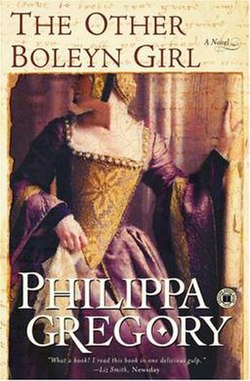Plot
In 1521 England, Queen Catherine of Aragon's failure to provide King Henry VIII a male heir has strained their marriage. Thomas Boleyn and his brother-in-law, Thomas Howard, Duke of Norfolk, plan to install Boleyn's youngest daughter Mary, wife of courtier William Carey, as the king's mistress. Mary's sister Anne, who recently returned from the French court, and brother George help Mary prepare, and Henry soon takes a liking to Mary, who despite her devotion to Queen Catherine falls in love with Henry. The affair strains Mary's friendship with the queen, especially after Mary becomes pregnant by the king.
Henry rewards Mary's family with lands and titles, elevating their status amongst the other noble families of the royal court. Anne catches the eye of Henry Percy, heir presumptive to the Duchy of Northumberland, and marries him in secret. Percy, however, is set to marry Mary Talbot, the daughter of the Earl of Shrewsbury. Cardinal Thomas Wolsey has the marriage annulled and "restores" Anne's virginity. She is sent away from court to their estate, Hever Castle as punishment.
Mary gives birth to a daughter in 1524 and names her Catherine. The king is somewhat indifferent to their daughter, who is presented as Mary's child with her husband, and they continue their affair. George reluctantly marries lady-in-waiting Jane Parker, and eventually admits to his sisters that he has romantic feelings for a man: Sir Francis Weston. Mary becomes pregnant by the king again, and her family returns Anne to court so that she can maintain the king's interest until the baby is born. Instead, Anne succeeds as seducing the king away from Mary just as she gives birth to a son, who is also presented as her husband's child.
The family's attentions shift to supporting Anne, who the king now favors. She resists his desires to make her his mistress, instead pressuring him to set Queen Catherine aside and marry her instead. Mary reconciles with her husband, William, and they share a brief period of happiness before he dies from the sweating sickness. She continues to support Anne, but longs to be with her children at Hever, which she is only permitted to visit each summer. Mary observes as Anne, for seven long years, strives to maintain the king's interest.
Eventually, Queen Catherine stands trial for the validity of her marriage to Henry. The king believes she consummated her previous marriage with his dead brother, Prince Arthur, and did not come into their marriage a virgin. The Queen is banished, and Anne, now engaged to marry Henry, adopts Mary's son to ensure she has a male heir to the throne.
Anne suffers a decline in popularity during her travels abroad, culminating in the King and Queen of France, who do not tolerate her position, refusing to meet her. She eventually sleeps with Henry after he grants her a title and marries him when he installs a new archbishop and proclaims himself Head of the Church of England. Anne gives birth to a daughter in 1533, whom she names Elizabeth. Anne, however, starts to lose the king's favor after several miscarriages and stillbirths.
Mary begins a relationship with Essex landowner William Stafford, despite their difference in rank. She marries him in secret and only tells her family when she becomes pregnant and can no longer hide the truth. Anne reacts with anger, jealous of Mary's pregnancy after her own repeated miscarriages and stillbirths.
Henry suffers an injury to his leg while jousting in 1536, and his time recovering stokes worries that public sentiment is turning. Meanwhile, Anne grows increasingly paranoid, convinced she has lost the support of her family and the country and that Henry is in love with her lady-in-waiting, Jane Seymour. She rejoices in her new pregnancy after hearing news of Queen Catherine's death. Mary meanwhile notices Anne's closeness with George, especially after Anne suffers another stillbirth and the child is deformed, leading to suspicions of incest or witchcraft.
Mary makes plans with William to travel for the country to avoid the turmoil. Before they can do so, Henry places Anne and George under arrest on charges of adultery and incest due to widespread belief that they slept together to give Anne her much-needed son. Anne later presents herself before the Privy Council, which finds her guilty. George and Weston are also convicted and beheaded.
Mary attends Anne's execution, believing that the king will spare her sister and send her to a nunnery, but Henry does not appear and her sentence is not commuted. Anne is executed and Mary swiftly leaves London with her husband and children.
